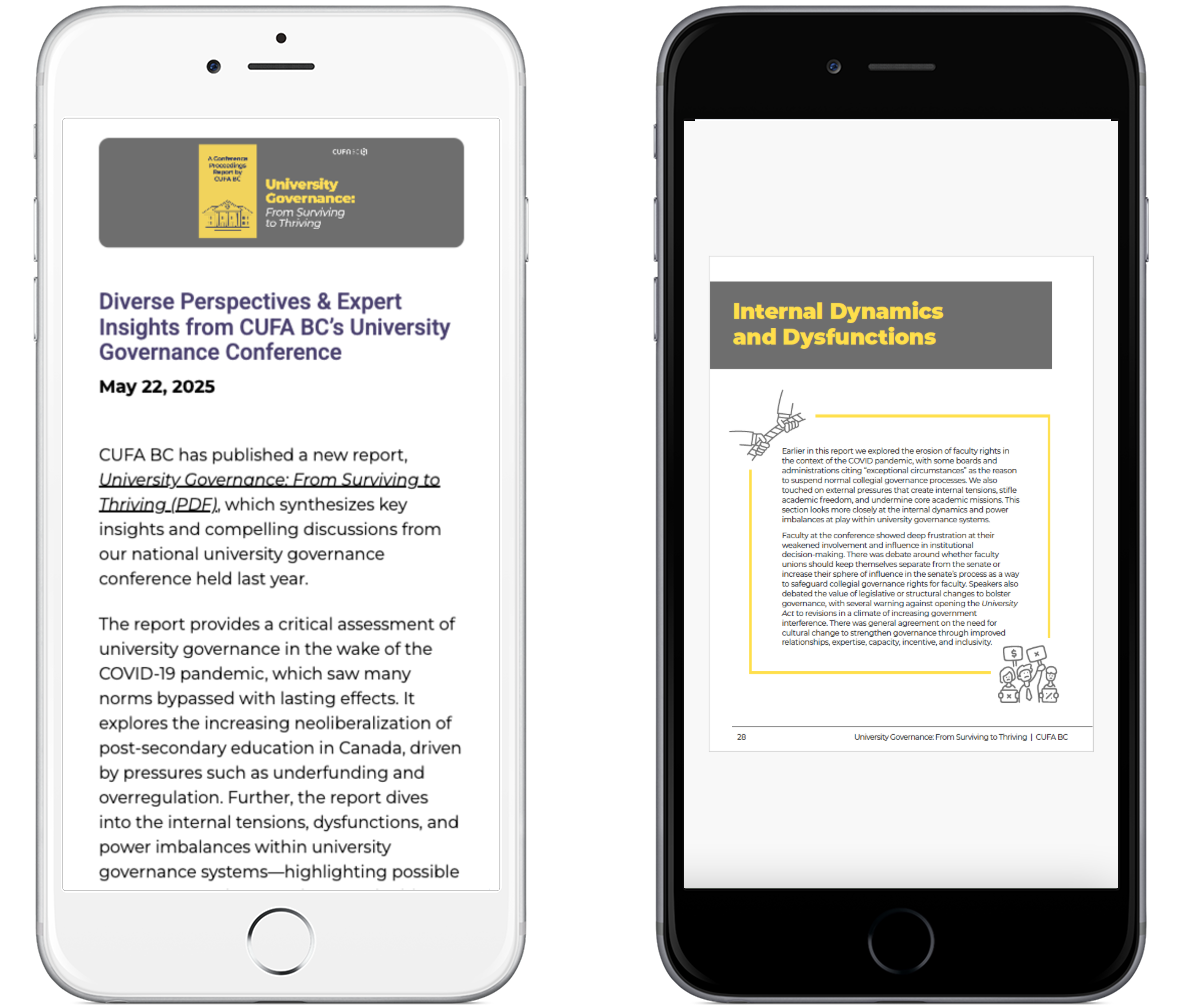#Whitepaper #PrintDesign #Storytelling
Conference report for a higher education confederation.
The client.
The Confederation of University Faculty Associations of British Columbia (CUFA BC) represents five university faculty unions in BC. The organization conducts research, analysis, and advocacy on post-secondary education issues. Every four years, it holds a conference on the topic of university governance—bringing together a diverse mix of university faculty, union leaders, administrators, staff, board members, and other stakeholders.
Our relationship.
CUFA BC initially hired me to provide content strategy and copywriting on their website redesign project in early 2025. The Executive Director, Annabree, was impressed with the finished product—a clean, professional site that drives the organisation’s mission forward. She also noticed I quickly gained a solid understanding of their audience and sector.
Soon after I completed the website work, Annabree asked me for help on another project—a report synthesising the learnings and outcomes of their 2024 conference. The report had been on the back burner while Annabree dealt with staff changes. So she was particularly pleased (“What a relief!”) when she learned I could design as well as write it.
Despite our 16-hour time difference, Annabree knows she can rely on me to move projects forward efficiently while keeping her in the loop. I build on her ideas and deliver strong drafts with minimal direction. At the same time, I ensure there are plenty of opportunities for feedback and collaboration, through both real-time calls and tools for asynchronous communication.
My work.
The challenge
Creating the conference report for CUFA BC required me to handle extremely complex, nuanced and sensitive topics.
The conference addressed serious issues in university governance—including chronic underfunding, government interference, discrimination in universities, and conflict between faculty and administration. The event lasted two days, hosted 20 speakers, and brought together 100+ people in various positions within the higher education sector.
The report needed to distill key insights from the conference, and reflect a diverse range of perspectives with fairness and clarity.
My process
To tackle this project, I began by reading transcripts from all seven conference sessions to gain a thorough understanding of the key concepts and perspectives.
I then mapped out common themes, connections, and contrasting viewpoints using Miro, which helped me visualise the material and plan the report’s structure.
From there, I drafted section headings and key points before diving into the writing—often referring back to the transcripts and my Miro map to ensure accuracy and coherence.
Once the copy was finalised, I used Adobe Express to design an engaging, professional layout optimised for readability. I delivered both digital and print-ready versions, ensuring the digital report was tagged for accessibility.
I kept the client closely involved throughout the whole process, providing regular updates and opportunities for feedback.
My approach
Conference reports often summarise individual sessions, but I recommended a different approach for this project. The event was highly collaborative—conversations spilled across sessions, and ideas evolved over the course of two days. I wanted the report to reflect this journey, with all its hurdles and turning points. This would give readers the same nuanced understanding as participants and convey the conference’s role in fostering dialogue and shared purpose.
I also recommended a section containing actionable takeaways. This would help ensure conversations didn’t end at the conference, but instead translated into concrete steps and sustained momentum.
The result
The final report offers clear, compelling insight into a complex and often contentious subject. It’s carefully structured to balance depth with readability, and to resonate with both faculty and administrators despite their big differences in perspective. Thanks to my plain language approach, the report is also accessible to audiences who are less familiar with university governance, such as government officials.
Each section of the report builds on the last, reflecting the flow of the conference itself. The narrative traces key discussions, highlighting impactful quotes and case studies, before ending with a set of actionable insights.
By combining rich analysis with storytelling, readability, and modern design, the report not only documents the conference but extends its impact—supporting CUFA BC’s goal to strengthen university governance across Canada.
“I highly recommend Peggy… She helped translate our technical jargon into more efficient and accessible language… She worked to deadline and always had good comments and feedback along the way.”
Annabree Fairweather, Executive Director at CUFA BC

